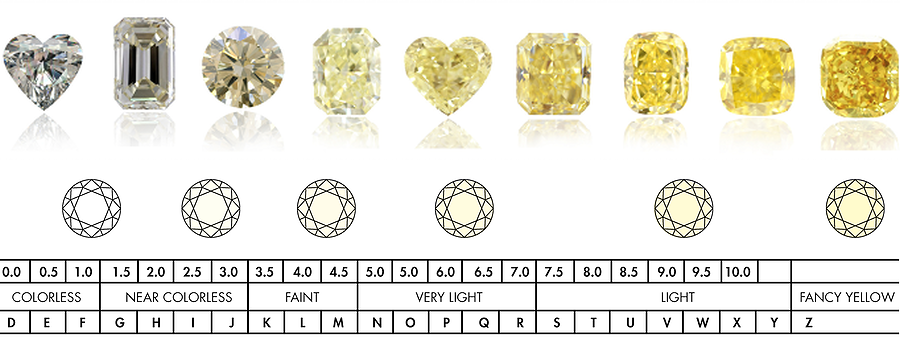All earth mined diamonds are assessed according to a universally accepted grading scale referred to as the 4Cs which stands for; Color, Cut, Clarity, and Carat Weight. It is by this standardized system that we can communicate how diamonds can be compared to one another. That way, you can determine what the best diamond is for you.
Two diamonds can theoretically have very similar characteristics at first glance but in actuality differ significantly from one another. This occurs when you are viewing them without the aid of a microscope or a jeweler's loupe, a 10X magnifying tool that allows the diamond to be viewed more closely.
However, even with a loupe, only a trained gemologist can truly determine exactly where a diamond resides on the 4 Cs grading scale. You may even find that a jeweler will add a 5th or 6th C when expressing a diamond’s traits. But this is simply an expression of their poetic license; those specifications will never appear on a proper diamond certificate.
1 COLOR
A diamond's color is expressed by the absence or presence of body color in the stone. On a scale from D–Z, the grade of D refers to a perfectly colorless diamond, while Z denotes a stone with significant yellow body color.
A diamond is valued higher as it closely it approaches colorlessness. This means that the rarest and also most valuable diamonds are those that rank closer to D on a color scale. Diamonds in the J – R range are considered to be more affordable and a beautiful alternative to the costliest stones.

The diamond color scale, from D (completely colorless) to Z (Fancy Yellow)
2 CUT
A diamond’s cut often determines its fire, sparkle, and its brilliance. After a diamond is recovered from the earth, the expert cutter very carefully assesses the optimal cut that can be created from the rough to produce the stone’s optimum beauty. Every diamond is evaluated individually to determine its highest potential and ideal cut.
The process involves a complicated evaluation of how to best achieve its symmetry, polish, durability, and the proportion of each of its parts – which subsequently determines how the light is captured and reflected in the stone. A cut grade is given ranging from Ideal, Premium, Very Good, Good, Fair, and Poor.
Ideal Cut, a category applied only to round diamonds, refers to diamond that have been cut to maximize its brilliance. Fair and Poor cut diamonds reflect only a small proportion of light back to the eye, and have been cut to maximize carat weight.

The diamond anatomy
3 CARAT
Carat expresses the weight of a diamond in a special unit called carats. Although it is a common misconception, carat weight is not the same thing as a diamond's size. Several factors can influence a diamond's size, not the least of which is its cut. Two diamonds can have the same carat weight but appear completely different in size because of the way that they are cut. Additionally, most people tend to judge a diamond's size by looking at it top-down. In that case, a diamond with a larger table facet may appear larger.
A carat is measured in points from 1-100; 100 points being 1.00 carat, 50 points being 0.50 carats, 25 points being .25 carats, and so forth. Generally, diamonds of very large carat weight will cost significantly more than diamonds of smaller carat weight. A diamond's carat weight is indisputable, since it is measured on a special diamond scale which can only result in one weight no matter who is measuring it.
 >
>
The diamond carat scale, From 0.05 to 2.0
4 CLARITY
Clarity expresses the internal and external inclusions (or flaws) that are present in a diamond. There are 7 clarity ranges on the grading scale: Flawless, Internally Flawless, Very, Very Slightly included, Very Slightly included, Slightly Included and Included.
Flawless (FL) means that the diamond has absolutely no blemish whatsoever inside or out. Internally Flawless (IF) means inclusions appear only on the surface of the stone but do not intrude into the diamond. Very, Very Slightly Included (VVS) has inclusions that are hardly visible only under 10X magnification. Very Slightly Included (VS) means fairly visible inclusions under 10X magnifications. The VS level has two sub categories (VS1 and VS2), with VS1 being a higher clarity grade than VS2. Slightly Included (SI) means the diamond has visible inclusions under 10X magnification.
This level has two sub categories (SI1 and SI2), with SI1 being a higher clarity grade than SI2. (I) Included diamonds have inclusions that are usually visible to the unaided eye.


Diamond Clarity Grade scale
Wrong username and/or password!
We could not log you in.

 |